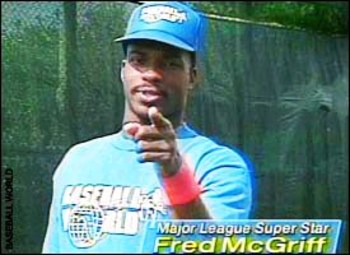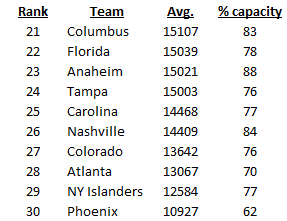FJM is derived from the now-dormant website FireJoeMorgan.com, the focus of which was baseball, not politics. If you think regular journalism is bad, you ought to see the cabbages that make a living writing about sports. Since the original authors of Fire Joe Morgan covered baseball so thoroughly, I borrowed their concept and applied it to opinion writing outside of the world of sports. I've never actually applied the technique to baseball as the original website did so well. Today that changes. It changes because I have seen something so stupid that I can't help myself. It changes because someone gave this asshead a column in which to regularly share the fruits of his intellect with the world:

His name is Tom Jones. I will strain mightily to avoid making any "What's New, Pussycat?" type jokes, but no promises. Folks, what you are about to see Mr. Jones drool onto his keyboard is so stupid that you will not even need a passing interest in baseball to appreciate it. In short, he is incredulous that Felix Hernandez of the Mariners was awarded the Cy Young Award on Thursday, the award given annually to the league's best pitcher as voted by sportswriters. Real ones, not Tom. Don't get me wrong, most of them are morons too. But after you read the following, Woody Paige will seem like Wordsworth in comparison. Are you read to learn why "Cy Young voters got it wrong"? Let me put it this way: if this guy is qualified to write about baseball, there's a rugby commentator job out there waiting for me.
FJM, this is for you.
Sorry, but I don't see how a pitcher who goes 13-12 can win the Cy Young Award as Seattle's Felix Hernandez did Thursday.
Here is a quick primer on how to tell if someone's opinions about baseball (and presumably anything else they'd want to talk about) are worth listening to: if they think Wins and Losses are the way to identify good pitchers, they are operating on about a 3rd grade level. If you show them two cars, they will insist that whichever one is larger or shinier is better.
Wins, to be blunt, are for stupids. To be credited with a win, a pitcher must throw at least five innings and leave the game with a lead. Great pitchers on horrible teams don't win many games. Bad pitchers on great teams often win a lot. Rick Fucking Helling won 20 games. So did Matt Morris. And Russ Ortiz. And Esteban Loaiza. Jose Lima. Bill Gullickson. Jamie Moyer (twice!). Winning 20 games means a guy can stay healthy enough to make every start, pitch league-average, and play on a team that scores a lot of runs. Some pitchers who win 20 are great, but they are not great because they win 20.
Tom Jones, you are a stupid person.
It means, essentially, that win-loss record is no factor.
That is exactly what it means, because Wins are for stupid people who don't understand how baseball works.
A 13-12 record is so mediocre that it could not have been considered at all by those who chose Fernandez. So does that mean he still would have won the award if his record was 12-13 and all of his other numbers were the same? The answer would have to be yes. What if he went 9-15?
Well the 13-12 record clearly wasn't "considered" by the voters, at least not in any manner that Tom Jones would like, but if King Felix managed to go 9-15 with the kind of stats he put up this year…yes, he'd probably get the award anyway.
Again, it would have to be yes because 13-12 was apparently eliminated from consideration.
What?
It's true that Hernanez is a heck of a pitcher. It's also true he pitched on a lousy team that lost 101 games. He shouldn't be penalized for that.
Well, it's "Hernandez". And that's mighty big of you to point out that this guy's team went 61-101. And Hernandez won 13 of those 61 games, which someone who thinks Wins matter should probably note.
But he can't be rewarded for it either.
It's not a "reward" to note that FIVE of his 12 losses were in starts in which he gave up two or fewer earned runs. Like when he pitched 8 innings on Sept. 23, surrendered one run, and lost 1-0 because Seattle couldn't score one goddamn run on Toronto.
No one can think or assume he would have posted a better record on a good team. You can't speculate or estimate that he would have gone, say, 20-10 if he had played for the Yankees or Rays or Rangers.
Can we assume that he might have gone 20-10 if he played on any team other than the one that scored ONE HUNDRED FEWER GODDAMN RUNS THAN ANY OTHER TEAM IN THE AMERICAN LEAGUE. 513 runs in 162 games, and the next worst offense scored 613. The Yankees (more on them in a minute) scored 859. The Mariners were dead last in the AL in hits, runs, home runs, on-base, and every other statistic you could possibly use to prove offensive ineptitude.
And I still contend that it's much easier to pitch when your team is 25 games out first place in September with no hope of a playoff spot than it is when you're pitching must-win games in the heat of the pennant race. You could argue that after the first few weeks of the season, Hernandez didn't pitch in a game that truly meant anything. Meantime, Tampa Bay's David Price and the Yankees' CC Sabathia pitched in critically meaningful games all season long.
Ah, yes, King Felix wasn't Gritty and Grindy and Clutchy enough because his team sucked. He must have been too busy trying to scratch out a few wins with THE WORST RUN SUPPORT OF ANY PITCHER IN BASEBALL. In Felix's 34 starts, the Mariners deigned to score a mighty 3.75 runs per game, absolute dead last in all of the majors. That he managed to win 13 is like the miracle of loaves and fishes.
It's one thing if there were no viable candidates besides Hernandez (13-12, 2.27 ERA), but certainly Price (19-6, 2.72) and Sabathia (21-7, 3.18) had worthy Cy Young numbers.
Ah, yes. Sabathia (Look at his magical 20+ wins), for whom the Yankees scored a ridiculous 7.31 runs per start. Almost exactly TWICE Hernandez's run support. Boy, I bet it's easier to win games when your teammates are swinging Wonderbat to the tune of almost 7.5 runs every time you take the mound. Price: 7.03 runs per start. Both pitchers run support was in the top 20 of all starters in baseball. Which is considerably higher than Hernandez, who was DEAD LAST.
What this proves is that the stat geeks — those who consider Moneyball to be the bible of baseball and sabermetics to be their gospel — have taken over the baseball world.
No, this proves that Tom Jones is a mouthbreathing jackass who has absolutely no concept of how dumb Wins are as a measure of a pitcher's ability. It proves that some sportswriters, neanderthals as they are, are slowly starting to realize that Wins are a measure of how many runs one's team scores.
It's all about WHIP and OPS and a bunch of other abbreviations that no one knows how to figure out.
If you can't "figure those out", you probably need help dressing yourself. Anyone beyond the most casual fan can explain basic statistics like this. WHIP (Walks and Hits per Inning Pitched) is a measure of baserunners allowed. OPS is On-Base plus Slugging. It means you add the two fucking numbers together. Tom, did you not feel somewhat like an asshole typing out this sentence? "Guhhhh. Snort. What the hell does "RBI" stand for? You eggheads and your statistical mumbo-jumbo."
It's not about baseball, where games and awards are won on the field with bats and gloves. It's about fantasy baseball, where games and awards are won on paper with a calculator and slide rule.
No, it's about the fact that Hernandez was a better pitcher and the games are won on the field with bats and gloves, and it is not Felix Hernandez's fault that the Mariners can't field or score any goddamn runs. Is it Hernandez's fault that Chone Figgins toed the Mendoza Line for 4 months? That Russell Branyan couldn't hit an off-speed pitch if he was given 15 strikes to work with per at-bat? That the Mariners routinely started lineups in which 7 of 9 players hit below .240? That Jose Lopez last took a walk in 1962?
Sabathia and Price, on the other hand, had to shield their eyes from the horror of their teammates beating the hell out of the opposing pitcher to the tune of SEVEN RUNS per start.
Things such as ERA and opponent's batting average and strikeouts and walks per nine innings, of course, should be considered when picking a Cy Young, but shouldn't a pitcher’s record count, too?
Yes, it should count. So let's total up the stats in which each pitcher prevailed:
Hernandez: strikeouts, walks, WHIP, innings pitched, opponent batting average, opponent OBP, opponent slugging pct., K/9 IP, BB/9 IP, K/BB, hits/9 IP, ERA, IP per start, average Game Score, P/PA, P/IP, Tough Losses (8), Cheap Wins (0), Quality Starts, Complete Games, Shutouts
Sabathia: Wins, body fat
Well, I'm sold.
In fact, shouldn't victories count as much or more than most numbers?
Sure, let's count it equally. To any of the 20 other stats in which Hernandez was far and away the better pitcher.
The issue I have is victories apparently were not counted at all.
No, you blathering jackass. The issue you have is a lack of basic reading comprehension skills and knowledge of baseball. Are wins supposed to be more important than every other stat, all of which prove that Felix was by far the best pitcher in the AL this year?
How else can you explain a starting pitcher with the fewest victories in a full season and a pitcher who was one game over .500 winning the Cy Young Award?
JESUS TAP-DANCING CHRIST, TOM. HOW SONOFABITCHING HARD IS THIS TO UNDERSTAND? IT IS EXPLAINED BY THE FACT THAT WINS ARE ONE STAT – AND A CRAPPY STAT, BUT WE'LL IGNORE THAT FOR A SECOND – COMPARED TO THE MOUNTAIN OF STATISTICAL EVIDENCE SHOWING HERNANDEZ TO BE THE SUPERIOR PITCHER. I FEEL LIKE I AM HAVING THIS CONVERSATION WITH A GARAGE DOOR.
It's a new day in baseball. A sad day.
I am sad about how stupid you are, and I can see why the original FJM guys got sick of dealing with this nonsense after three years.
Tom, please, I mean this sincerely: you need to find a new line of work. This is the dumbest argument I have ever seen, and I grade the work of 18 year old Georgia public high school graduates for a living.








